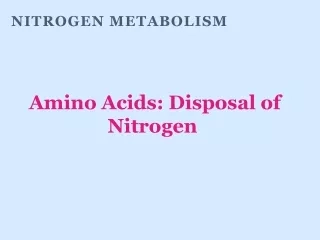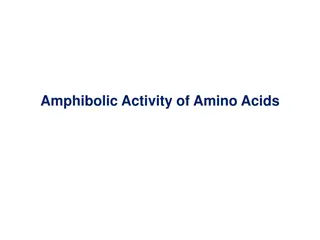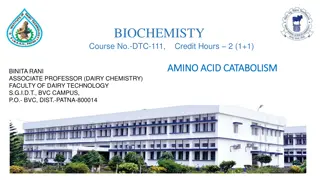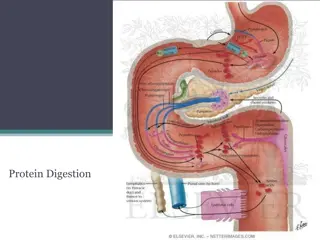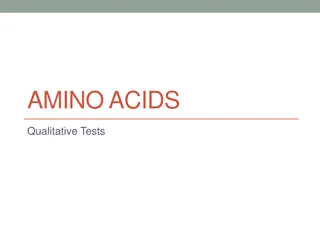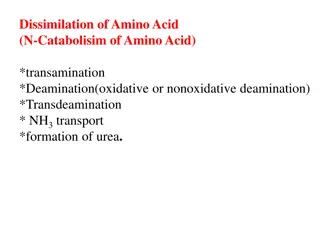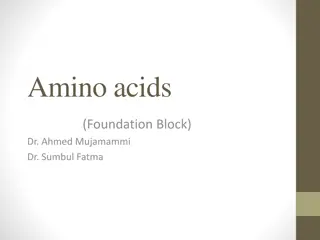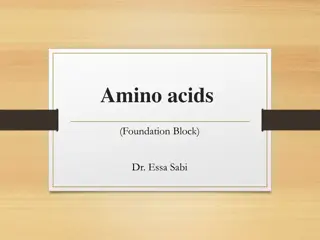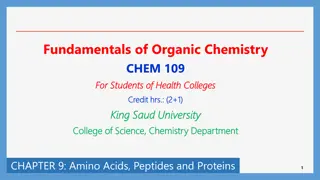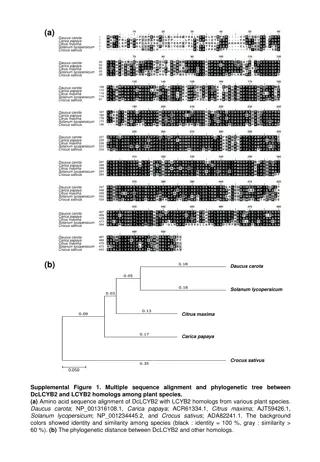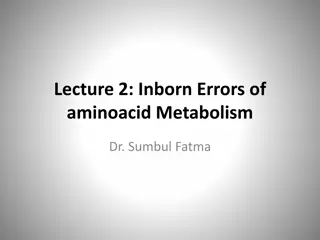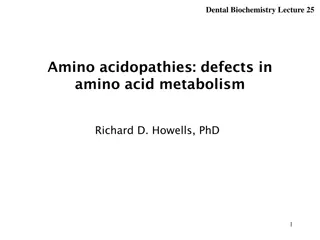Amino Acid: Structure and Classification Overview
Amino acids are essential building blocks of proteins, with only 20 out of the 300 occurring in nature being used for protein synthesis. The structure of amino acids consists of four groups attached to a central carbon atom. At physiological pH, these groups can ionize, forming zwitterions. Amino acids are classified based on their side chain properties, chemical characteristics, nutritional roles, and metabolic functions. There are polar amino acids that can form hydrogen bonds and non-polar amino acids that do not participate in hydrogen bond formation. Understanding the structure and classification of amino acids is crucial in studying protein synthesis and biological processes.
Download Presentation

Please find below an Image/Link to download the presentation.
The content on the website is provided AS IS for your information and personal use only. It may not be sold, licensed, or shared on other websites without obtaining consent from the author.If you encounter any issues during the download, it is possible that the publisher has removed the file from their server.
You are allowed to download the files provided on this website for personal or commercial use, subject to the condition that they are used lawfully. All files are the property of their respective owners.
The content on the website is provided AS IS for your information and personal use only. It may not be sold, licensed, or shared on other websites without obtaining consent from the author.
E N D
Presentation Transcript
AMINO ACID: STRUCTURE AND CLASSIFICATION. AMINO ACID: STRUCTURE AND CLASSIFICATION. Amino Acids are the building units of proteins. There are about 300 amino acids occur in nature. Only 20 of them enter in proteins synthesis. Structure Structure of of amino Four different groups are attached to - carbon: amino group COOH group Hydrogen atom and side Chain (R). amino acids acids: :
At physiological pH (7.4), -COOH group is dissociated forming a carboxylate ion (COO- ) and amino group is protonated forming positively charged ion (NH3 + ) forming Zwitter ion . negatively charged
Classification Classification of of Amino I. Classification by R group II. Chemical Classification III. Nutritional Classification IV. Metabolic Classification Amino Acids Acids: :
Classification by R group Classification by R group
Classification Classification according Polar Polar amino amino acids hydrophilic group so can forms hydrogen bond with H2O. In those amino acids, R may contain: according to to polarity acids: in which R contains polar polarity of of side side chain chain (R) (R): : OH group : as in serine, threonine and tyrosine - SH group : as in cysteine amide group: as in glutamine and aspargine NH2 group or nitrogen act as a base (basic amino acids ): as lysine, arginine and histidine COOH group (acidic amino acids): as aspartic and glutamic .
Non Non polar polar amino which can t enter in hydrogen bond formation. amino acids acids: R is alkyl hydrophobic group 9 amino acids are non-polar ( glycine, alanine, valine, leucine, isoleucine, phenyl alanine, tryptophan, proline and methionine).
The twenty twenty common referred to using three-letter abbreviations. The structures, names, and abbreviations for the twenty common amino acids are shown below. Note that they are all - -amino amino acids common amino amino acids acids are often acids.
Each amino acid, aside from its name, has a three letter abbreviation and a one letter code.
Nutritional Classification Nutritional Classification 1- Essential Amino Acids 10 in number, Can t be synthesized in the body, essential to be taken in diet. Their deficiency affects growth, health and protein synthesis. 2- Semi-essential formed in the body but not in sufficient amount for body requirements especially in children. Arginine and histidine are semi- essential . 3- Non-essential can be synthesized in the body.
Non Non Standard Standard Amino > 700 non standard amino acids have been detected in living organisms. Many are metabolic intermediates eg. ornithine and citrulline are intermediates in urea biosynthesis Amino Acids Acids Amino Amino Acid Chemical derivatives of amino acids also have important biological functions, eg. Catecholamines (below) lack the a-carboxylate of amino acids Acid Derivatives Derivatives
GABA & Dopamine are neurotransmitters. Histamine mediates parts of the immune response.
Functions Functions of of Amino Apart from being the monomeric constituents of proteins and peptides, amino acids serve variety of functions. Amino Acids Acids (a) (a) Some amino acids are converted to carbohydrates and are called as glucogenic amino amino acids acids. glucogenic
(b) (b) Specific amino acids give rise to specialised products, e.g. Tyrsione Tyrsione forms hormones such as thyroid hormones hormones, (T3, T4), epinephrine epinephrine and norepinephrine and a pigment called melanin melanin. thyroid norepinephrine Tryptophan Tryptophan can synthesise a vitamin called niacin niacin. Glycine, Glycine, arginine creatine creatine. arginine and and methionine methionine synthesise
Glycine and cysteine help in synthesis salts salts. synthesis of of Bile Bile Glutamate, glutathione glutathione. cysteine and glycine synthesis decarboxylation. Serotonin Serotonin is formed from tryptophan. Histidine Histidine changes to histamine histamine on Glycine is used for the synthesis of haem haem. .
Pyrimidines and purines use several amino acids for their synthesis such as aspartate and glutamine for pyrimidines and glycine, aspartic acid, Glutamine and serine for purine synthesis c) c) Some amino acids such as glycine and cysteine are used as detoxicants of specific substances. (d) (d) Methionine acts as active methionine (S-adenosylmethionine) and transfers methyl group to various substances by transmethylation. (e) (e) Cystine and methionine are sources of sulphur

 undefined
undefined





